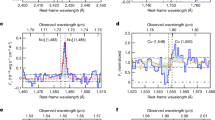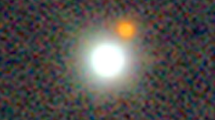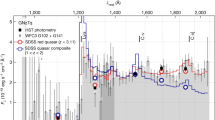Abstract
Observations of quasars reveal that many supermassive black holes (BHs) were in place less than 700 Myr after the Big Bang. However, the origin of the first BHs remains a mystery. Seeds of the first BHs are postulated to be either light (that is, 10−100 M⊙), remnants of the first stars, or heavy (that is, 10−105 M⊙), originating from the direct collapse of gas clouds. Here, harnessing recent data from the Chandra X-ray Observatory, we report the detection of an X-ray-luminous massive BH in a gravitationally lensed galaxy identified by the James Webb Space Telescope at redshift z ≈ 10.3 behind the cluster lens Abell 2744. This heavily obscured quasar with a bolometric luminosity of ~5 × 1045 erg s−1 harbours an ~107−108 M⊙ BH assuming accretion at the Eddington limit. This mass is comparable to the inferred stellar mass of its host galaxy, in contrast to what is found in the local Universe wherein the BH mass is ~0.1% of the host galaxy’s stellar mass. The combination of such a high BH mass and large BH-to-galaxy stellar mass ratio just ~500 Myr after the Big Bang was theoretically predicted and is consistent with a picture wherein BHs originated from heavy seeds.
This is a preview of subscription content, access via your institution
Access options
Access Nature and 54 other Nature Portfolio journals
Get Nature+, our best-value online-access subscription
$29.99 / 30 days
cancel any time
Subscribe to this journal
Receive 12 digital issues and online access to articles
$119.00 per year
only $9.92 per issue
Buy this article
- Purchase on Springer Link
- Instant access to full article PDF
Prices may be subject to local taxes which are calculated during checkout




Similar content being viewed by others
Data availability
The JWST data of Abell 2744 are publicly available at MAST (http://archive.stsci.edu). The Chandra data are available upon request from the corresponding author.
References
Castellano, M. et al. Early results from GLASS-JWST. III. Galaxy candidates at z~9–15. Astrophys. J. Lett. 938, L15 (2022).
Castellano, M. et al. Early results from GLASS-JWST. XIX. A high density of bright galaxies at z ≈ 10 in the A2744 region. Astrophys. J. Lett. 948, L14 (2023).
Harikane, Y. et al. A comprehensive study of galaxies at z ~ 9–16 found in the early JWST data: ultraviolet luminosity functions and cosmic star formation history at the pre-reionization epoch. Astrophys. J. Suppl. Ser. 265, 5 (2023).
Naidu, R. P. et al. Two remarkably luminous galaxy candidates at z ≈ 10–12 revealed by JWST. Astrophys. J. Lett. 940, L14 (2022).
Atek, H. et al. Revealing galaxy candidates out to z ~ 16 with JWST observations of the lensing cluster SMACS0723. Mon. Not. R. Astron. Soc. 519, 1201–1220 (2023).
Adams, N. J. et al. Discovery and properties of ultra-high redshift galaxies (9 < z < 12) in the JWST ERO SMACS 0723 field. Mon. Not. R. Astron. Soc. 518, 4755–4766 (2023).
Treu, T. et al. The GLASS-JWST Early Release Science Program. I. Survey design and release plans. Astrophys. J. 935, 110 (2022).
Bezanson, R. et al. The JWST UNCOVER Treasury survey: Ultradeep NIRSpec and NIRCam Observations before the Epoch of Reionization. Preprint at https://arxiv.org/abs/2212.04026 (2022).
Fruscione, A. et al. CIAO: Chandra’s data analysis system. In Proc. Society of Photo-Optical Instrumentation Engineers Conference Series Vol. 6270 (eds. Silva, D. R. & Doxsey, R. E.) 62701V (SPIE, Bellingham, 2006).
HI4PI Collaboration et al. HI4PI: a full-sky H I survey based on EBHIS and GASS. Astron. Astrophys. 594, A116 (2016).
Yaqoob, T. The nature of the Compton-thick X-ray reprocessor in NGC 4945. Mon. Not. R. Astron. Soc. 423, 3360–3396 (2012).
Goulding, A. D. et al. High-redshift extremely red quasars in X-rays. Astrophys. J. 856, 4 (2018).
Duras, F. et al. Universal bolometric corrections for active galactic nuclei over seven luminosity decades. Astron. Astrophys. 636, A73 (2020).
Madau, P. & Rees, M. J. Massive black holes as Population III remnants. Astrophys. J. Lett. 551, L27–L30 (2001).
Hirano, S. & Bromm, V. Formation and survival of Population III stellar systems. Mon. Not. R. Astron. Soc. 470, 898–914 (2017).
Chon, S., Ono, H., Omukai, K. & Schneider, R. Impact of the cosmic background radiation on the initial mass function of metal-poor stars. Mon. Not. R. Astron. Soc. 514, 4639–4654 (2022).
Smith, B. D. et al. The growth of black holes from Population III remnants in the Renaissance simulations. Mon. Not. R. Astron. Soc. 480, 3762–3773 (2018).
Pacucci, F., Natarajan, P., Volonteri, M., Cappelluti, N. & Urry, C. M. Conditions for optimal growth of black hole seeds. Astrophys. J. Lett. 850, L42 (2017).
Loeb, A. & Rasio, F. A. Collapse of primordial gas clouds and the formation of quasar black holes. Astrophys. J. 432, 52 (1994).
Lodato, G. & Natarajan, P. Supermassive black hole formation during the assembly of pre-galactic discs. Mon. Not. R. Astron. Soc. 371, 1813–1823 (2006).
Begelman, M. C., Volonteri, M. & Rees, M. J. Formation of supermassive black holes by direct collapse in pre-galactic haloes. Mon. Not. R. Astron. Soc. 370, 289–298 (2006).
Lodato, G. & Natarajan, P. The mass function of high-redshift seed black holes. Mon. Not. R. Astron. Soc. 377, L64–L68 (2007).
Agarwal, B., Davis, A. J., Khochfar, S., Natarajan, P. & Dunlop, J. S. Unravelling obese black holes in the first galaxies. Mon. Not. R. Astron. Soc. 432, 3438–3444 (2013).
Wise, J. H. et al. Formation of massive black holes in rapidly growing pre-galactic gas clouds. Nature 566, 85–88 (2019).
Lupi, A., Haiman, Z. & Volonteri, M. Forming massive seed black holes in high-redshift quasar host progenitors. Mon. Not. R. Astron. Soc. 503, 5046–5060 (2021).
Devecchi, B. & Volonteri, M. Formation of the first nuclear clusters and massive black holes at high redshift. Astrophys. J. 694, 302–313 (2009).
Alexander, T. & Natarajan, P. Rapid growth of seed black holes in the early universe by supra-exponential accretion. Science 345, 1330–1333 (2014).
Natarajan, P. A new channel to form IMBHs throughout cosmic time. Mon. Not. R. Astron. Soc. 501, 1413–1425 (2021).
Volonteri, M., Lodato, G. & Natarajan, P. The evolution of massive black hole seeds. Mon. Not. R. Astron. Soc. 383, 1079–1088 (2007).
Ricarte, A. & Natarajan, P. The observational signatures of supermassive black hole seeds. Mon. Not. R. Astron. Soc. 481, 3278–3292 (2018).
Natarajan, P. et al. Unveiling the first black holes with JWST: multi-wavelength spectral predictions. Astrophys. J. 838, 117 (2017).
Larson, R. L. et al. A CEERS Discovery of an accreting supermassive black hole 570 Myr after the Big Bang: identifying a progenitor of massive z > 6 quasars. Astrophys. J. Lett. 953, L29 (2023).
Maiolino, R. et al. A small and vigorous black hole in the early Universe. Preprint at https://arxiv.org/abs/2305.12492 (2023).
Di Matteo, T., Angles-Alcazar, D. & Shankar, F. Massive black holes in galactic nuclei: theory and simulations. Preprint at https://arxiv.org/abs/2304.11541 (2023).
Di Matteo, T., Croft, R. A. C., Feng, Y., Waters, D. & Wilkins, S. The origin of the most massive black holes at high-z: BlueTides and the next quasar frontier. Mon. Not. R. Astron. Soc. 467, 4243–4251 (2017).
Alvarez, M. A., Wise, J. H. & Abel, T. Accretion onto the first stellar-mass black holes. Astrophys. J. Lett. 701, L133–L137 (2009).
Kim, J.-H., Wise, J., Alvarez, M. & Abel, T. Galaxy formation with self-consistently modeled stars and massive black holes. I. Feedback-regulated star formation and black hole growth. Astrophys. J. 738, 54 (2011).
Jiang, Y.-F., Stone, J. M. & Davis, S. W. Super-Eddington accretion disks around supermassive black holes. Astrophys. J. 880, 67 (2019).
Regan, J. A. et al. Super-Eddington accretion and feedback from the first massive seed black holes. Mon. Not. R. Astron. Soc. 486, 3892–3906 (2019).
Sassano, F., Capelo, P. R., Mayer, L., Schneider, R. & Valiante, R. Super-critical accretion of medium-weight seed black holes in gaseous proto-galactic nuclei. Mon. Not. R. Astron. Soc. 519, 1837–1855 (2023).
Massonneau, W., Dubois, Y., Volonteri, M. & Beckmann, R. S. How the super-Eddington regime affects black hole spin evolution in high-redshift galaxies. Astron. Astrophys. 669, A143 (2023).
Eilers, A.-C. et al. Implications of z ~ 6 quasar proximity zones for the epoch of reionization and quasar lifetimes. Astrophys. J. 840, 24 (2017).
Chen, H. & Gnedin, N. Y. The distribution and evolution of quasar proximity zone sizes. Astrophys. J. 911, 60 (2021).
Cash, W. Parameter estimation in astronomy through application of the likelihood ratio. Astrophys. J. 228, 939–947 (1979).
Leccardi, A. & Molendi, S. Radial temperature profiles for a large sample of galaxy clusters observed with XMM-Newton. Astron. Astrophys. 486, 359–373 (2008).
Owers, M. S. et al. The dissection of Abell 2744: a rich cluster growing through major and minor mergers. Astrophys. J. 728, 27 (2011).
Larson, R. L. et al. Spectral templates optimal for selecting galaxies at z > 8 with JWST. Preprint at https://arxiv.org/abs/2211.10035 (2022).
Wang, F. et al. A luminous quasar at redshift 7.642. Astrophys. J. Lett. 907, L1 (2021).
Willott, C. J. et al. Eddington-limited accretion and the black hole mass function at redshift 6. Astron. J. 140, 546–560 (2010).
Mortlock, D. J. et al. A luminous quasar at a redshift of z = 7.085. Nature 474, 616–619 (2011).
Bañados, E. et al. An 800-million-solar-mass black hole in a significantly neutral Universe at a redshift of 7.5. Nature 553, 473–476 (2018).
Acknowledgements
This research has made use of data obtained from the Chandra Data Archive and software provided by the Chandra X-ray Center (CXC) in the application packages CIAO and Sherpa. We thank helpful discussions with F. Pacucci, A. Ricarte and P. Edmonds. Á.B., G.R.T., R.P.K., C.J. and W.R.F. acknowledge support from the Smithsonian Institution and the CXC through NASA contract NAS8-03060. A.D.G. acknowledges support from NSF/AAG grant no. 1007094. P.N. acknowledges support from the Black Hole Initiative at Harvard University, which is funded by grants from the John Templeton Foundation and the Gordon and Betty Moore Foundation. O.E.K. is supported by the GAČR EXPRO grant no. 21-13491X.
Author information
Authors and Affiliations
Contributions
Á.B. is the principal investigator of the Chandra proposal, analysed the Chandra observations, led the analysis and drafted the paper. A.D.G. and P.N. contributed equally. A.D.G. carried out the spectral fitting of the X-ray source, played a major role in writing the paper and provided a figure. P.N. led the theoretical interpretation and played a major role in writing the paper. O.E.K. contributed to the analysis of the Chandra data and its interpretation and provided a figure. G.R.T. contributed figures and text to the paper. U.C. contributed to the sample selection and data analysis. M.V. contributed to the interpretation and text of the paper. R.P.K. contributed to the interpretation of the paper. W.R.F., C.J., E.C. and I.Z. reviewed the paper and contributed to the text.
Corresponding author
Ethics declarations
Competing interests
The authors declare no competing interests.
Peer review
Peer review information
Nature Astronomy thanks the anonymous reviewers for their contribution to the peer review of this work.
Additional information
Publisher’s note Springer Nature remains neutral with regard to jurisdictional claims in published maps and institutional affiliations.
Supplementary information
Supplementary Information
Supplementary Figs. 1 and 2, Table 1, text and references.
Rights and permissions
Springer Nature or its licensor (e.g. a society or other partner) holds exclusive rights to this article under a publishing agreement with the author(s) or other rightsholder(s); author self-archiving of the accepted manuscript version of this article is solely governed by the terms of such publishing agreement and applicable law.
About this article
Cite this article
Bogdán, Á., Goulding, A.D., Natarajan, P. et al. Evidence for heavy-seed origin of early supermassive black holes from a z ≈ 10 X-ray quasar. Nat Astron 8, 126–133 (2024). https://doi.org/10.1038/s41550-023-02111-9
Received:
Accepted:
Published:
Issue Date:
DOI: https://doi.org/10.1038/s41550-023-02111-9



